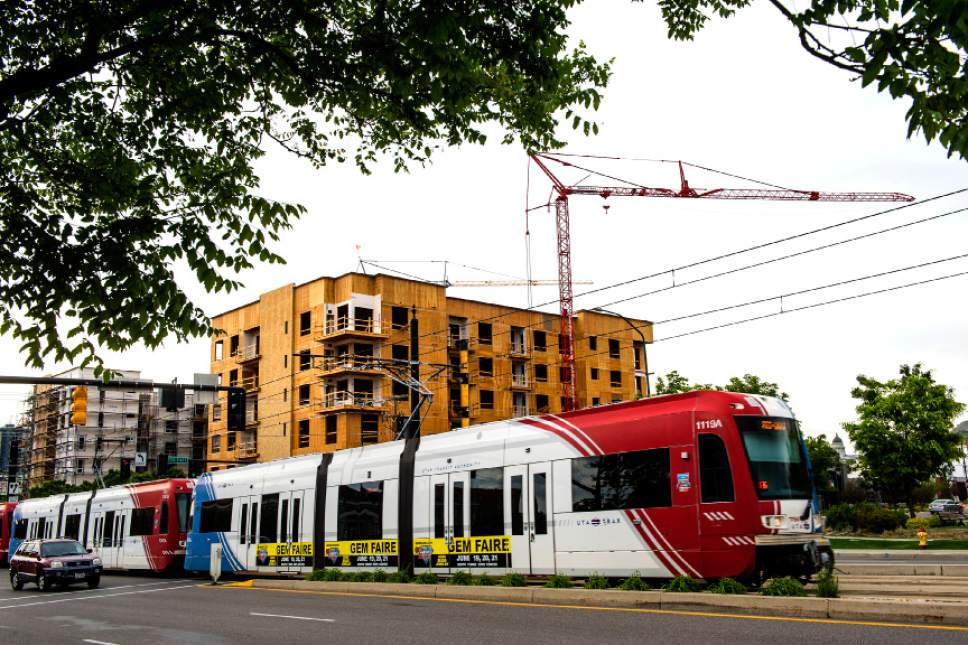This is an archived article that was published on sltrib.com in 2016, and information in the article may be outdated. It is provided only for personal research purposes and may not be reprinted.
The Utah Transit Authority is dropping long-in-the-works plans to convert to a "distance-based fare" system in which riders would pay for actual miles traveled instead of a flat fee for trips of any length.
"Staff consistently heard from the public and stakeholders that a distance-based fare structure was too complex, with minimal appeal and perceived value," UTA spokesman Remi Barron said Wednesday. "As a result, UTA decided not to implement a systemwide, distance-based fare structure."
That came as part of a report by the agency on how well it achieved its 2015 goals, which had included a mandate to finish studies on distance-based fares and make a final decision on whether to implement them.
UTA reported that it met 55 percent of goals set by its board for last year, which may lead to lower bonuses for administrators. That included missing a goal to boost ridership by 3.3 percent. Instead, ridership dipped as lower gas prices enticed more motorists to drive.
"We conducted extensive market and public research" on distance-based fares over the past 18 months, acting UTA CEO Jerry Benson told the UTA Board's Finance and Operations Committee.
The agency found that customers said the system would be too confusing, and they did not like not knowing what their fare would be until they finished their trip — or did research online beforehand.
"What customers told us is keep it simple and keep it affordable," he said. "They really did not see value in distance-based fare as a concept. So as a result, our decision was 'no go.' "
One reason UTA implemented its FAREPAY electronic fare-card system in recent years was to allow possible distance-based fares.
But electronic payments have also allowed UTA to better track where people travel to adjust schedules for easier transfers, helped lower the costs of collecting fares and quickened boarding.
Some Salt Lake City officials had voiced support for distance-based fares, figuring it would lower costs for their residents because most of their trips are shorter. Of course, it could raise prices for suburbanites with longer commutes.
Benson said UTA studies found little support overall.
"Sometimes what seems like a great idea, if it doesn't have value to your customers or the community, it's just not worth doing," he said. "That's why you do research."
UTA conducted an eight-month experiment with distance-based pricing on three bus routes in Utah County.
While it showed that such fares are feasible, it also found several "readiness gaps" showing more work was needed to ensure accurate calculation and charging of fares.
Written information Benson gave to the board said, "UTA continues to evaluate future fare policy and alternative fare structures, with a plan to develop and present a comprehensive fare proposal in 2016 for public comment and board approval." UTA has been reviewing its many discounts and passes as part of such work.
Meanwhile, Benson said 2015's ridership of about 46.6 million rides was about 23,000 rides fewer than 2014's. UTA had set a goal to increase ridership to at least 48.1 million.
"We know that when fuel [cost] declines as dramatically as it did last year, that we're typically going to see a decline in ridership," Benson said. "We're actually happy to be reporting that our ridership held steady."
He noted that transit ridership nationally dropped by 1.3 percent amid lower gas prices.
UTA avoided a bigger drop, Benson said, by tapping savings from lower fuel costs to improve frequency of some bus, TRAX and streetcar service, and by continuing discounts for using its FAREPAY cards.
"The routes and services where we did improve service," he added, "saw a pretty significant increase in their ridership, about a 31 percent [jump] in daily average ridership."
While lower gas prices may have hurt ridership, they helped UTA hit a goal to lower its tax subsidy per ride — the cost not covered by fares — which it calls "investment per rider."
It had a goal to hold that to $4.01. It fell to $3.79. Without those fuel-cost savings, the subsidy would have come in exactly at $4.01, Benson said.
In part because of lower fuel costs, he reported that UTA spent 5.1 percent less than it budgeted last year.
The agency overall hit 55 percent of all board goals last year.
So Finance and Operations Committee members recommended that administrators split 55 percent of a money pool set aside for possible bonuses, with no credit for goals that were met partially. The full board will decide whether to enact that recommendation.
UTA's top executives voluntarily withdrew for two years from that bonus program amid controversy about some bonuses that had been as high as $30,000. But lower-level administrators still can earn bonuses, which were capped recently by the board to a maximum of $7,500.
Besides board goals, Benson mentioned some other achievements by UTA last year.
He said the agency has a high rate of on-time reliability: 92.4 percent for buses, 98 percent for paratransit, 94 percent for TRAX and 86.6 percent for FrontRunner.
Benson added that safety rates are high. The rate of avoidable accidents by buses is now 0.71 per 100,000 miles driven. "That is well-beyond what people thought was possible several years ago."





